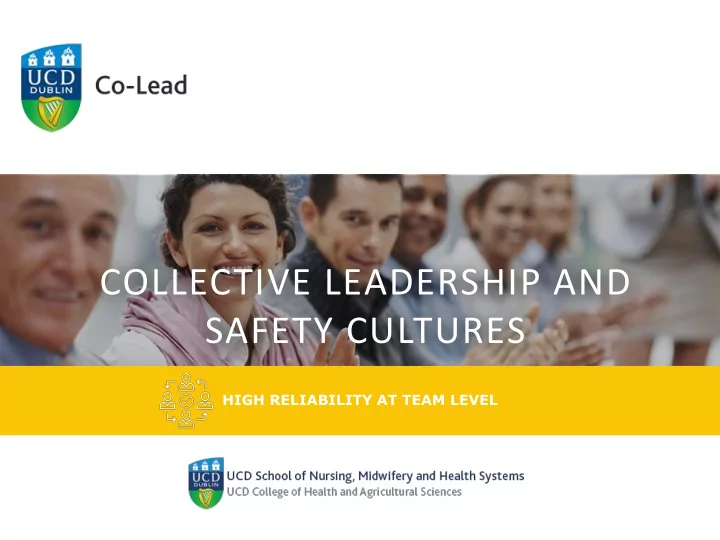

Improving joy and meaning in work COLLECTIVE LEADERSHIP AND (COLLECTIVE LEADERSHIP FOR TEAM PERFORMANCE) SAFETY CULTURES 1 HIGH RELIABILITY AT TEAM LEVEL
High reliability “The unusual capacity to produce collective outcomes of a certain minimum quality repeatedly” (Hannan & Freeman, 1984) Organisational reliability is thought to be achieved through the development of highly standardised routines. Co-Lead
Collective safety awareness “A shared team focus on achieving high safety through an on-going effort to update and optimise routines, procedures and actions based on experience and anticipation” A safety aware team is willing to scrutinise perceptions and expectations to make sense of and learn from new events. Co-Lead
High Reliability Organisations (H (HROs) Organisations that work in a potential high-risk environment, but perform nearly error-free. The most efficient HROs are found in: Co-Lead
Number of global deaths from aviation in 2017? 399 (B3A annual review) Number of deaths associated with preventable patient harm in the US each year? Uncertain, but likely between 210.000 and 400.000 (James, 2013) Co-Lead
Characteris istics of settings wit ith HROs An unforgiving social and political environment Potential high risk environment The scale of consequences of errors Complex processes and procedures precludes learning from experience (Sutcliffe 2011) Co-Lead
Refle lection and dis iscussion (2 (2-3 min in.) Think about an incident where preventable harm either came or could have come to a patient. It can be an incident or near miss that you have been involved in or heard about at work/in the media. Consider the following: • If you were responsible for the overall patient safety for your team/department, what would you do to prevent a similar incident from happening in future? • Be concrete! What policies, guidelines, procedures, equipment, training, etc. would you implement/change to prevent a similar incident? Share and discuss your suggestions in groups of 2-3. Co-Lead
Characteristics of f HROs • High collective safety awareness • Strive to achieve zero harm • Systems/routines in place to minimise the risk/consequences of inevitable human error • Authority patterns based on functional skill (expertise over formal rank) • Encourage the reporting of errors and make the most of any failure that is reported • No punitive/blame culture Co-Lead
Five key processes underlie high collective safety awareness in HROs Reluctance to simplify Preoccupation with failure interpretations Everyone is aware of, thinking about, and People avoid simplifying their understanding preparing for the potential for failure of how and why things succeed or fail in their environment. Sensitivity to operations Commitment to resilience “Situational awareness” – awareness of Coping with, containing, and bouncing back context and how that may impact on safety. from mistakes. Deference to expertise Deference to local and situational expertise rather than formal rank. Co-Lead (Adapted from Weick, et al. 2007, Sutcliffe 2011, AHRQ 2018)
GROUP DIS ISCUSSION (1 (10 min in) Th The e tea eam is is sp split lit in into 5 5 groups – eac each group is is provid ided wi with th read eadin ing materia ial ab about on one of of the the key processes. Eac ach group wi will ll discu iscuss: • What t do o we e do o well ell as a tea eam in in rel elation to o th this is process? • What t can an we e im improve on on in in rel elati tion to o th this is process? Groups sh Gr should ld tak ake not otes of of the their disc iscussion an and prepare to exp xpla lain in th their sp specific process an and key disc iscussion poin oints to o th the whole team durin ring tea eam discu iscussion. Co-Lead
TE TEAM DIS ISCUSSION (3 (30 min in.) For each key process, use the following structure: • Subgroup briefly explains the process (what it is/how to achieve it) • Subgroup feeds back their main discussion points • Whole team to discuss: • How do we improve in relation to this process? • What actions can we take? • Who will be responsible? 1. Preoccupation with failure A team member should take notes 2. Reluctance to simplify interpretations of the discussion/fill in the Co- Lead template, paying particular 3. Sensitivity to operations attention to any concrete actions 4. Commitment to resilience discussed/decided by the team 5. Deference to expertise If any time is left, try to rank the key processes 1-5 based on which processes the team needs to prioritise the most. Co-Lead
Thank you 12 Co-Lead
Recommend
More recommend